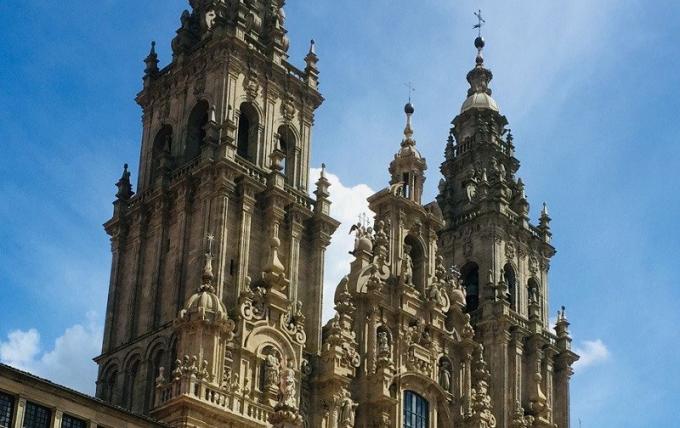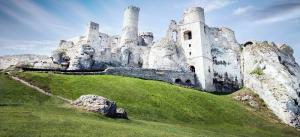What is the origin of the Camino de Santiago?
The Camino de Santiago is probably one of the most popular destinations today. What was originally a pilgrimage, traced by numerous pilgrims who wanted to achieve some divine favor or expiate some sin, is today a trip that brings many and varied surprises: cultural wonders, extraordinary landscapes and the opportunity to meet people from different provenances.
You may be wondering when, how and why the pilgrimage to Santiago de Compostela began. In this article we try to solve your doubts and we propose a trip towards the origin of the Camino de Santiago.
The historical origin of the Camino de Santiago
Since the origins of Christianity, the relics of saints and saints have been part of popular devotion. Not long after the death of Christ and the first followers of him began to proliferate the discoveries of remains of characters who had played an important role in the history of the Christianity.

There are different types of relics; there are those that correspond to fragments of the body, such as bones, hair, teeth or skulls, but we also find the called “touch relics”, which become sacred because they have supposedly been touched by a character holy. This is the case of cloaks, parts of footwear or objects that the person in question owned during his life.
During the Middle Ages, the possession of relics was essential to guarantee the wealth of a city or a territory. Keeping some holy remains ensured the flow of pilgrims, and that meant economic gains for the inhabitants of the place, since these pilgrims stayed overnight and ate in hostels. In addition, we must remember that, at that time, it was necessary to have a relic to be able to consecrate a church, so the need to possess sacred remains became more pressing if fits.
The great importance of the possession of relics (not only on a spiritual level, but also economic), involved considerable trafficking in supposedly sacred remains during the years of the Middle Ages. The falsification and the substitution of this type of elements were the order of the day; This is one of the reasons why, currently, there are so many relics scattered around the world, whose history and origin are full of enormous contradictions.
- Related article: "The 5 ages of History (and their characteristics)"
The first Jacobean pilgrim was a king
The legend tells, collected in the chronicle Concord Antealtares (written in 1077), which, Around the year 813, a hermit named Pelayo or Paio saw strange lights appear in the sky, whose glow began to repeat itself night after night.. Often, the luminaries would have apparitions of angels, so Pelayo was sure that a message was being delivered to him from Heaven.
Not only the hermit had witnessed the lights. Other witnesses to the miracle emerged, which is why the Bishop of Iria Flavia, Teodomiro, took a keen interest in the phenomenon. After verifying for himself the appearance of the night lights, the bishop decreed an official fast of three days and marched towards the place indicated by the luminaries with a handful of faithful. There, according to the Concordia Antealtares, the tomb of the Apostle Santiago was discovered.
It seems that it was Teodomiro himself who notified Alfonso II the Chaste, who was then on the throne of Asturias, of the discovery. In a copy of a monarch's diploma, dated to the 12th century (that is, a century later), 834 is given as the year in which the discovery of the sepulcher was reported to the king. The same document attests that Alfonso went to venerate the relics of the apostle together with a retinue of nobles from his court and gave the order to build a basilica in the same place where they were found.
History has remembered Alfonso II as the first Jacobean pilgrim, although it is very likely that it was something more than faith that prompted the monarch to promote the pilgrimage. The discovery of the tomb of Santiago Apóstol would, of course, guarantee the flow of pilgrims towards their territories, which would entail the consolidation of their borders and the increase of their riches. On the other hand, the consolidation of a Christian route in the north of the peninsula also guaranteed the permanence of Christianity in the area; Let us remember that the rest of the Iberian territory was at that time in the hands of the Muslims.
- You may be interested in: "Middle Ages: the main characteristics of this historical stage"
Are they really the remains of Santiago?
The first question that may assail us is the following: how can it be that Santiago was buried in Galicia, when his martyrdom occurred in Jerusalem?
The answer seems to be in the third book of the Calixtino Codex, called precisely Liber de translatione corporis sancti Jacobi ad Compostellam (Book of the transfer of Santiago to Compostela), where it is said that, after the martyrdom and death of the apostle, the disciples take his body and board a boat with him. After several days of crossing (seven, specifically), the faithful and the remains of the apostle arrive at Iria Flavia, a Roman city located in Gallaecia.
The story of Santiago from the Calixtino Codex, written in the 12th century, is a compilation of older stories that would have been transmitted orally since the beginning of Christianity. The oldest mention that locates the apostle in Hispanic lands is the Breviary of the Apostles, a text written in the sixth century that He claimed that Santiago had preached in Hispanic lands, that he had died there and that he was buried in a place called Arca Marmarica. The story spread throughout Europe, spurred on by the De ortu et obitu Patrum of San Isidoro de Sevilla, where the bishop collected the history of the preaching of Santiago in Hispania. According to the first tradition, therefore, the famous Jacobi transfer (Transfer of the body of Santiago) from Jerusalem to Galicia never took place.
However, this version was in clear contradiction with the book of the Acts of the Apostles, which claimed that the place of martyrdom and death of Santiago had been Jerusalem. Therefore, it was evident that the body of the apostle had indeed been transferred to Hispania, and this was reflected in subsequent stories, duly seasoned with completely legendary elements.
The question is, then, the following: are the remains of Santiago really those that lie in the current cathedral of Santiago de Compostela?
- Related article: "What is Cultural Psychology?"
The popularization of the Jacobean route
Although the pilgrimage to Santiago began to acquire fame in the first centuries of the Middle Ages, andThe height of its popularity occurred in the 11th century, when Pope Callixtus II and Cluny Abbey strongly supported the Jacobean route..
Among the causes of the growing interest in the Camino de Santiago we have the increasing difficulty with which found the pilgrims when they went to the other great pilgrimage centers of Christendom: Rome and Jerusalem. The first was completely devoted to the struggle between the Pope and the Holy Roman Emperor, to the detriment of spirituality; the second, though recently conquered by the Crusader army, still posed a considerable risk to any pilgrim seeking to reach it.
On the other hand, the eleventh and twelfth centuries are the centuries of the takeoff of the cities. The medieval cultural and economic landscape was changing, and urban life was beginning to acquire an importance not seen since classical times. Consequently, there are many pilgrims who leave the cities with Santiago de Compostela as their goal. A goal that has lasted to this day, although it has lost, practically in its entirety, the spiritual and religious meaning of medieval times.


